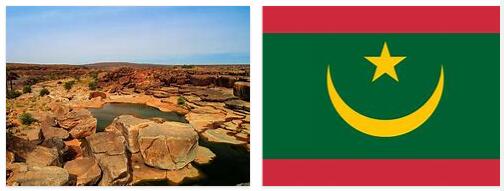(Al-Jumhūrīyah al-Islāmīyah al-Mūritanīya). State of Northwest Africa (1,030,700 km²). Capital: Nouakchott. Administrative division: regions (Wilaya) (13). Population: 3,161,000 residents (2008 estimate). Language: Arabic (official), French, poular, soninke, Wolof. Religion: Sunni Muslims 99.3%, Christians 0.3%, others 0.4%. Monetary unit: ouguiya (5 khoum). Human Development Index: 0.557 (140th place). Borders: Western Sahara (annexed by Morocco) (NW), Algeria (NE), Niger, Mali (S and E), Senegal (SW), Atlantic Ocean (W). Member of: ECOWAS, Arab League, OCI, UN, AU and WTO, EU associate.
THE STATE
Mauritania is a democratic republic. On the basis of the Constitution approved in 2006, the President of the Republic is elected by direct suffrage for a 5-year term renewable once. Legislative power is divided between the National Assembly, whose members are elected by universal suffrage every 5 years, and the Senate, whose members are elected by indirect suffrage every 6 years. The judicial system is based on Islamic law (shari’ah); in 1980 an Islamic Tribunal was established. At the top of the system remain the Supreme Court and the Appeal Court based in Nouakchott. The death penalty is in force, but executions have not taken place since 1987. The defense of the country is entrusted to the armed forces, divided into the three traditional weapons. Military service is carried out on a compulsory basis and lasts for 2 years. The school structure of Mauritania partly retains the regulations introduced by France. Primary school, compulsory and free, goes from 6 to 12 years. According to andyeducation, the secondary school lasts 6 years and is divided into two microcycles of 3 years each. Despite numerous efforts by the government, the illiteracy rate remains high: 44.2% in 2007. In 1983, Nouakchott University was opened.
TERRITORY: ENVIRONMENT
The vegetation is very poor. The savannahs of the extreme southern belt (sahel), which host palms, acacias and sparse baobabs, are succeeded by stunted shrubs proceeding N and towards the interior of the desert, therefore open vegetal associations, consisting of succulent and thorny plants. The camel it is the most common animal in desert regions, and there are also thousands of bird species that migrate from Europe to the inland areas of the country in the winter to reproduce. Due to the advance of the sands and indiscriminate hunting, giraffes and lions have now disappeared; the monk seal, also threatened by extinction, survives in the Capo Bianco lake. Over-exploitation of pastures, deforestation, soil erosion and long periods of drought are among the primary causes of desertification, the country’s most pressing environmental problem. The protected area covers a total of 1.5% of the territory, within which there are two national parks, the most important of which is the Banc d’Arguin National Park, UNESCO.
ECONOMY: TRADE AND COMMUNICATIONS
The trade balance, in surplus in 2006, denounced heavy liabilities from the second half of the seventies; the country imports foodstuffs, vehicles and means of transport, fuels, industrial products, while, in addition to iron, the only exports are practically represented by fish and copper ores. The foreign debt was US $ 2281 million in 2005. § The only railway line, 697 km long (2005), is the one, mainly used for the transport of minerals, which connects the Fdéric fields with the port of Nouâdhibou; the sector, after being penalized in the seventies, by the events of the fight against the Polisario Front, generally suffers from difficulties in the procurement of raw materials. The roads (9144 km in total in 2005) are mainly represented by Néma, near the border with Mali. Heavy traffic still takes place on the Senegal River. The main maritime outlet is Point-Central, located 10 km S of Nouâdhibou, the ports of Nouâdhibou, Cansado and Nouakchott are also important; the latter city is home to an international airport.
CULTURE: GENERAL INFORMATION
The craftsmanship in Mauritania is very much alive: the manufacture of silver is particularly accurate, as is the processing of leather. They also produce drapes, paintings, sculptures, fabrics and ceramics. It is thought that the most skilled artisans have secrets for their work, which are handed down from generation to generation. UNESCO inscribed the ancient cities of Oudane and Chinguetti (Adrar region), Tichitt (Tagant region) and Oualata (Hodh Echchargut region) on the World Heritage List (in 1996). Founded in the 11th and 12th centuries for the caravans crossing the Sahara, these trading and religious centers became nerve centers of Islamic culture. Very interesting is their urban structure which evolved between the 12th and 16th centuries: patio houses huddle along narrow streets around a mosque with a square minaret. They represent an example of the traditional lifestyle of the nomadic culture of the peoples of Western Sahara. The houses have little decoration and the furniture is sparse. Food has an important psychological and social function: people eat together using a large bowl, and using their right hand according to Muslim usage. Usually you eat first and then drink cold water or sour milk mixed with water, hibiscus or baobab juice. After lunch and dinner, Moors use to drink small glasses of green tea with sugar and mint. Tea is served by boys, women or slaves. The diet is based on meat, millet, rice, fish, potatoes and sweet potatoes. For blacks, the main meal is midday, while for the Berbers it is that of the evening. For breakfast in the morning they consume milk and cereals, with French bread and butter. For cooking, a lot of oil is used and a lot of sugar is put into drinks. In addition to civil holidays, the most important celebrations are those linked to the Islamic religion.
